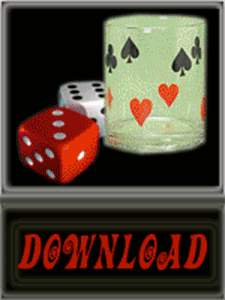Pokerwiner.com → Lessons of poker
SITUATIONS WHEN EFFECTIVE ODDS NEED NOT APPLY
There are a few times when you do not have to consider future bets when assessing your pot odds. The first case occurs when either you or your opponent is all-in or almost all-in. Obviously, when your opponent has no more money to bet or you have no more money to call, the last card will be free.
So all you need to do is observe your immediate pot odds and compare them to your chances of winding up with the best hand. In the example. Just given, if eight you or your opponent were all-in when the opponent bet $10 on the flop and you called, it would be worth drawing to your back-door flush since it would now be a case of getting 26-to-1 on a 24-to-1 shot. However, you must remember that the chances of making the hand you are drawing to are not the same as your chances of winding up with the best hand. You might make your hand and still lose to a better hand.
There is a second case, similar to the first, when you might call in close situations even id your effective odds would indicate a fold. This comes up when you have good reason to think your opponent might check on the you have good reason to think your opponent might check on the next round. If he does check, you are getting a free card just as though you or he were all-in.
Once again all you need to consider are your immediate pot odds, since you expect to see two cards for the price of one. Such situations might come up when you suspect your opponent has a weak hand or when you think your opponent might fear to bet on the next round because he interprets your call to mean you’re stronger than you really are, even when you don’t catch the card you need. Finally, it may sometimes be correct to call to see one card only when your effective odds indicate a fold. If that card does not make your hand, you should not call any further bets.
These circumstances usually occur in games where there is a large increase in the bet from one round to the next. You might, for example, be playing in a $10-$50 holdem game and catch a four-flush on the flop. Your opponent bets $10 into a $40 pot, and you expect he’ll bet $50 on the next round. To call both bets would mean you were getting effective odds of 100-to-60, too low for you to contemplate going all the way with a flush draw.
However, you are getting 5-to-1 on your opponent’s first bet, which is greater than the odds against hitting on the next card (not to mention your potential profits on the last two betting rounds should you hit the flush). When deciding whether to call for one card only, all you need to consider are your immediate pot odds versus your chances of hitting on the next card only. In most cases, however, when you have a hand that needs to improve, you must realize that future bets cut down your apparent pot odds substantially, frequently enough to make you throw the hand away. Therefore, before deciding to go all the way with a hand, you must calculate whether the effective odds you are getting by calling several rounds of betting justify a call now.
CALCULATING EFFECTIVE ODDS
Figuring effective odds may sound complicated, but it is a simple matter of addition. You add all the calls you will have to make, assuming you play to the end, to determine the total amount you will lost if you don’t make your hand. Then compare this figure to the total amount you should win if you do make the hand. This total is the money in. The pot at the moment plus all future bets you can expect to win, excluding your own future bets.
Thus, if there is $100 in the pot at the moment and three more $20 betting rounds, you are getting $160-to-$60 effective odds if both you and your opponent figure to call all bets. If you know you won’t call on the end unless you make your hand, your opponent won’t call on the end unless you make your hand, your effective odds become $160-to-$40. When you think your opponent won’t call on the end if your card hits, your effective odds would be reduced to something like $140-to-$40. If, on early betting rounds, these odds are greater than your chances of making your hand, you are correct to see the hand through to the end. If they are not, you should fold.



